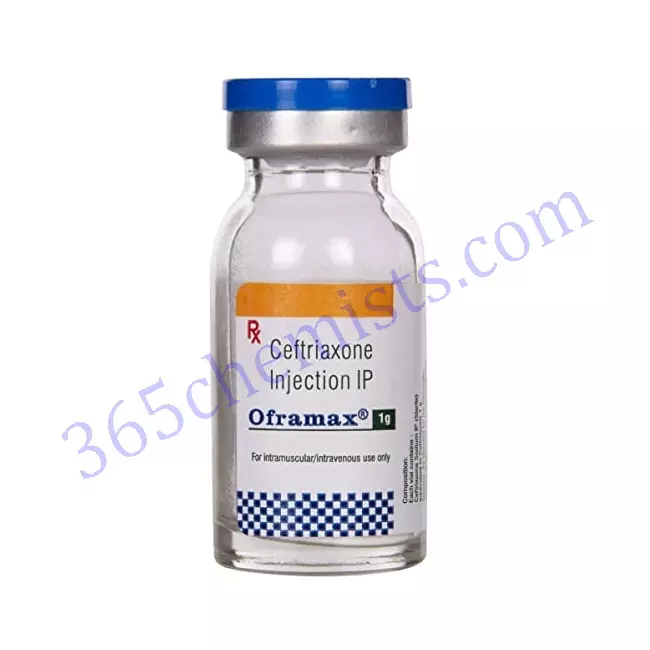Oframax 1gm Injection: Potent Antibiotic Treatment with Ceftriaxone
Ceftriaxone is the primary component of the medicine known as Oframax 1gm Injection, which also contains the medication. It is categorised as an antibiotic belonging to the group known as cephalosporins and is employed in the treatment of a wide variety of bacterial infections. This article will provide a detailed explanation of Oframax 1gm Injection, covering topics such as its applications, recommended dosage, potential adverse effects, and essential safety considerations to keep in mind.
Uses of Oframax 1gm Injection:
The use of Oframax 1gm Injection for the treatment of a wide variety of bacterial infections is extremely effective. The following are the scenarios in which it is utilised:
- Infections of the Respiratory Tract Pneumonia, Bronchitis, and Tonsillitis Are Some of the Conditions Treated by Oframax 1gm Injection It is prescribed for respiratory tract infections such as these. It helps combat the growth and spread of bacteria, which in turn helps to lessen the severity of the symptoms associated with these infections.
- Infections of the Urinary Tract Cystitis and pyelonephritis are two types of urinary tract infections that can be treated with the medication that is being discussed. The urinary symptoms and discomfort can be alleviated with the use of Oframax 1gm Injection because it helps eliminate the bacteria that are responsible for the infection.
- Infections of the Skin and Soft Tissues: The Oframax 1gm Injection is also effective in treating infections of the skin and soft tissues caused by susceptible bacteria. These infections include cellulitis, abscesses, and wound infections. It accomplishes this by preventing the growth of bacteria, accelerating the healing process, and lessening the likelihood of complications.
Related Product
Oframax 1gm Injection
Oframax Forte 1.5g Injection
Dosage and Administration:
Oframax 1gm A trained medical professional will inject the medication into the patient’s vein intravenously. It is possible for the dosage and length of treatment to change depending not only on the nature and extent of the infection, but also on the age of the patient and the state of their health. It is essential to take the medication exactly as directed, in the correct quantity, and for the full duration of the recommended treatment course.
Depending on the severity of the infection and the instructions provided by the physician, the typical recommended dosage for adults is 1 gramme (1 vial) of Oframax Injection once or twice a day. This is the normal recommended dosage. The injection is given slowly over a period of time ranging from half an hour to two hours.
Important Precautions:
- A hypersensitivity to ceftriaxone or any other cephalosporin antibiotics is a contraindication for using Oframax 1gm Injection. People who are aware that they have this condition should avoid using the medication. Before beginning the treatment, it is essential to provide the healthcare provider with complete and accurate information regarding any known allergies or adverse reactions to medications.
- Oframax 1 gramme for optimal kidney and liver function Patients who have impaired kidney or liver function should only receive injections under very close medical supervision. During treatment, it is essential to perform vigilant monitoring of both renal and hepatic function.
- Pregnancy and Breastfeeding: It has not been thoroughly investigated whether or not Oframax 1gm Injection is safe to use during pregnancy or breastfeeding. If you are pregnant, breastfeeding, or have plans to become pregnant while taking this medication, you should discuss your options with a qualified medical professional before beginning treatment.
Common Side Effects:
Oframax 1gm Injection is generally well tolerated, but just like any other medication, it has the potential to cause a variety of adverse effects. Some people experience pain or redness at the injection site, nausea, vomiting, diarrhoea, headaches, and dizziness after receiving the medication. These adverse effects are typically mild and fleeting, and they go away on their own without further medical intervention. In the event that they continue or become worse, it is imperative to seek medical attention.
Even though serious adverse effects, such as severe allergic reactions, liver problems, and changes in blood cell counts are uncommon, you should seek immediate medical attention if you experience any of these symptoms. In the event that any symptoms develop that are either unusual or severe, immediate medical attention needs to be sought.
Drug Interactions:
It is imperative that you provide your primary care physician with information regarding all of the medications you are presently taking. This includes not only prescription drugs but also over-the-counter medications, herbal supplements, and vitamin products. It is possible for other medications to have an effect on how well Oframax 1gm Injection works or to raise the risk that it will have unwanted side effects. Notify your primary care provider if you are currently taking any of the following:
In addition to these antibiotics, concurrent use of 1 gramme of Oframax An increase in the risk of adverse effects or a reduction in the effectiveness of both medications is possible if the antibiotics in question are administered via injection. Your physician will determine the most effective course of treatment for you.
Anticoagulants: Oframax 1gm The risk of bleeding may be increased as a result of the interaction between injection and anticoagulant medications such as warfarin. In these kinds of situations, it is essential to perform vigilant monitoring of the blood clotting parameters.
Storage:
Oframax 1gm Injections should be kept in a dark, cool, and dry location away from any sources of light. It ought to be stored in a location that is inaccessible to both children and animals. If the injection’s packaging is damaged or if it has passed its expiration date, you should not use it.
Summary:
Ceftriaxone is the active ingredient in the powerful antibiotic medication known as Oframax 1gm Injection. This medication is used to treat infections of the respiratory tract, urinary tract, skin and soft tissue. A qualified medical professional will give it to the patient via intravenous injection. Some people experience pain or redness at the injection site, nausea, vomiting, diarrhoea, headaches, and dizziness after receiving the medication. Individuals who suffer from allergies, those who have issues with their kidneys or livers, pregnant women, and mothers who are breastfeeding need to take extra precautions. There is a possibility that Oframax 1gm Injection will interact with other medications; therefore, it is essential to inform the healthcare provider about all medications that are currently being taken. It is imperative to both store items correctly and pay attention to their use-by dates. Patients can experience the benefits of Oframax 1gm Injection’s efficacy in treating bacterial infections if they adhere to the guidelines that have been provided and discuss their treatment with a qualified medical professional.












